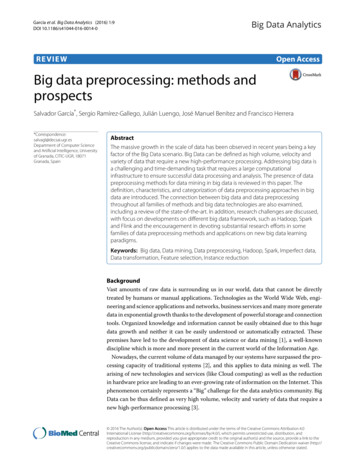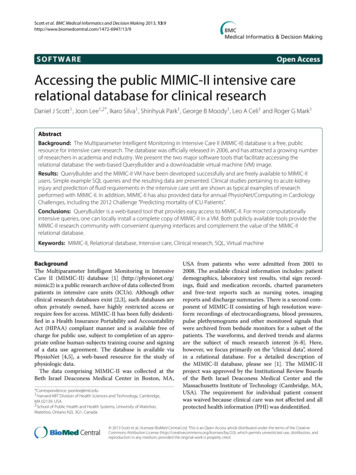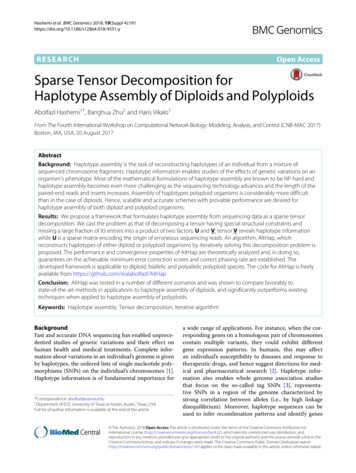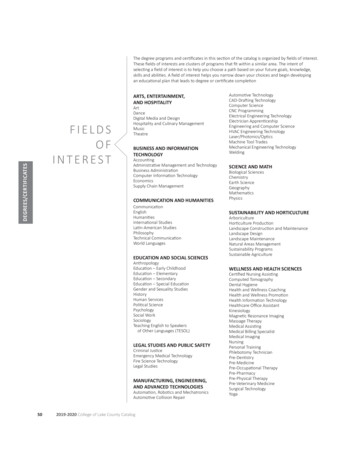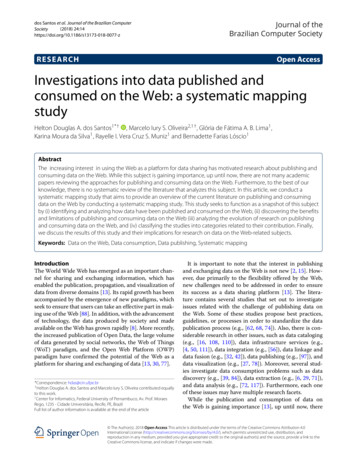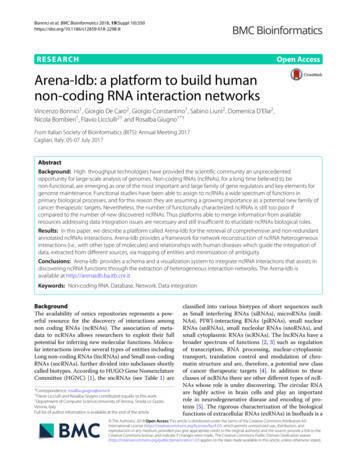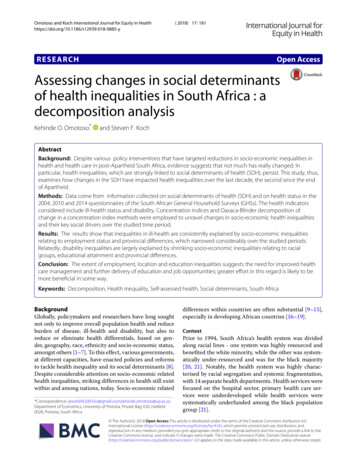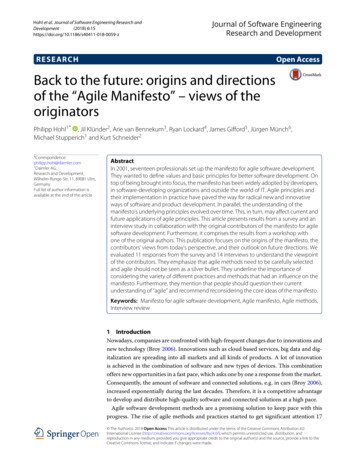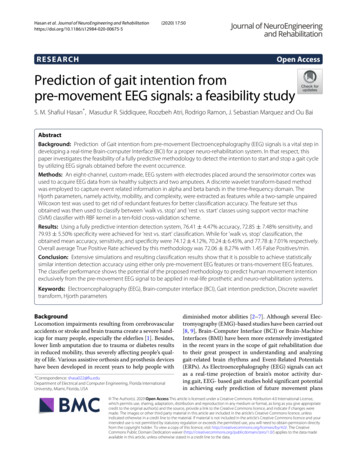
Transcription
Hasan et al. Journal of NeuroEngineering and 0675-5(2020) 17:50RESEARCHOpen AccessPrediction of gait intention frompre-movement EEG signals: a feasibility studyS. M. Shafiul Hasan* , Masudur R. Siddiquee, Roozbeh Atri, Rodrigo Ramon, J. Sebastian Marquez and Ou BaiAbstractBackground: Prediction of Gait intention from pre-movement Electroencephalography (EEG) signals is a vital step indeveloping a real-time Brain-computer Interface (BCI) for a proper neuro-rehabilitation system. In that respect, thispaper investigates the feasibility of a fully predictive methodology to detect the intention to start and stop a gait cycleby utilizing EEG signals obtained before the event occurrence.Methods: An eight-channel, custom-made, EEG system with electrodes placed around the sensorimotor cortex wasused to acquire EEG data from six healthy subjects and two amputees. A discrete wavelet transform-based methodwas employed to capture event related information in alpha and beta bands in the time-frequency domain. TheHjorth parameters, namely activity, mobility, and complexity, were extracted as features while a two-sample unpairedWilcoxon test was used to get rid of redundant features for better classification accuracy. The feature set thusobtained was then used to classify between ’walk vs. stop’ and ’rest vs. start’ classes using support vector machine(SVM) classifier with RBF kernel in a ten-fold cross-validation scheme.Results: Using a fully predictive intention detection system, 76.41 4.47% accuracy, 72.85 7.48% sensitivity, and79.93 5.50% specificity were achieved for ’rest vs. start’ classification. While for ’walk vs. stop’ classification, theobtained mean accuracy, sensitivity, and specificity were 74.12 4.12%, 70.24 6.45%, and 77.78 7.01% respectively.Overall average True Positive Rate achieved by this methodology was 72.06 8.27% with 1.45 False Positives/min.Conclusion: Extensive simulations and resulting classification results show that it is possible to achieve statisticallysimilar intention detection accuracy using either only pre-movement EEG features or trans-movement EEG features.The classifier performance shows the potential of the proposed methodology to predict human movement intentionexclusively from the pre-movement EEG signal to be applied in real-life prosthetic and neuro-rehabilitation systems.Keywords: Electroencephalography (EEG), Brain-computer interface (BCI), Gait intention prediction, Discrete wavelettransform, Hjorth parametersBackgroundLocomotion impairments resulting from cerebrovascularaccidents or stroke and brain trauma create a severe handicap for many people, especially the elderlies [1]. Besides,lower limb amputation due to trauma or diabetes resultsin reduced mobility, thus severely affecting people’s quality of life. Various assistive orthosis and prosthesis deviceshave been developed in recent years to help people with*Correspondence: shasa022@fiu.eduDepartment of Electrical and Computer Engineering, Florida InternationalUniversity, Miami, Florida, USAdiminished motor abilities [2–7]. Although several Electromyography (EMG)-based studies have been carried out[8, 9], Brain-Computer Interface (BCI) or Brain-MachineInterfaces (BMI) have been more extensively investigatedin the recent years in the scope of gait rehabilitation dueto their great prospect in understanding and analyzinggait-related brain rhythms and Event-Related Potentials(ERPs). As Electroencephalography (EEG) signals can actas a real-time projection of brain’s motor activity during gait, EEG- based gait studies hold significant potentialin achieving early prediction of future movement plans The Author(s). 2020 Open Access This article is licensed under a Creative Commons Attribution 4.0 International License,which permits use, sharing, adaptation, distribution and reproduction in any medium or format, as long as you give appropriatecredit to the original author(s) and the source, provide a link to the Creative Commons licence, and indicate if changes weremade. The images or other third party material in this article are included in the article’s Creative Commons licence, unlessindicated otherwise in a credit line to the material. If material is not included in the article’s Creative Commons licence and yourintended use is not permitted by statutory regulation or exceeds the permitted use, you will need to obtain permission directlyfrom the copyright holder. To view a copy of this licence, visit http://creativecommons.org/licenses/by/4.0/. The CreativeCommons Public Domain Dedication waiver ) applies to the data madeavailable in this article, unless otherwise stated in a credit line to the data.
Hasan et al. Journal of NeuroEngineering and Rehabilitation(2020) 17:50which researchers can readily utilize for more effectiverehabilitation of motor-impaired persons providing themwith necessary motor capabilities.Prediction of human movement intention is highly significant for successful gait rehabilitation. In a BCI-basedrehabilitation system, the brain waves are extracted, processed, and translated to control an assistive device. Foran effective assistive system, it is critical to detect themovement intention as early as possible to provide thesystem with enough time to adapt to the requirement ofthe individual [10]. There have been two majorly reportedneural features related to movement intention detection.Those are Movement-Related Cortical Potential (MRCP)[11–13] and Event-Related Synchronization/ Desynchronization (ERS/ ERD) [14, 15]. MRCP corresponding toself-paced movement is known as Bereitschafts Potential(BP), and it is characterized by a slow decrease in EEGamplitude over the primary motor cortex within at least0.5 s preceding the movement initiation. On the otherhand, ERD is defined as a decrease in spectral power 0.52 s before movement onset reported most in the mu (812 Hz) and beta (13-30 Hz) frequency bands of the brainwave [16–18]. The limits of the frequency bands may differ across different authors. These features have been usedas physiological triggers to activate and operate variousassistive devices [19–21].Although ERD [22, 23] and MRCP [24–26] based studies have been carried out quite extensively in understanding unique aspects of motor cortex activation, both ofthese modalities have some drawbacks. MRCP providestiming information about different stages of movementplanning and execution. But it is a very subtle change innear DC frequencies and it takes multiple repetitions ofthe same trial to extract useful and reliable gait-relatedinformation from MRCP [27]. On the other hand, ERDhas been shown to be detectable from single trial EEG, butthe main disadvantage of using ERD as a control signal forassistive devices is that it does not provide precise timinginformation about different stages of movement planning,preparation, and execution. Moreover, ERD/ERS requiresa reliable steady state baseline to correctly detect powerchanges correlated to movement intention. The currentstudies [28, 29] either use EEG signal from both beforeand after the movement initiation and termination or usea large portion of pre-movement EEG data for properbaseline information. Such systems are, therefore, impractical in online real-time BCI application and may becomeprone to erroneous or delayed detection of intention inthe presence of sudden intention to move. To addressthe shortcoming of the traditional features, in this paperHjorth parameters, namely activity, mobility and complexity are proposed as features to obtain instantaneoustime-frequency information related to gait intention inPage 2 of 16a window by window approach without the necessity ofbaseline selection.Besides, very few studies have explored pre-movementstate for healthy subjects in the context of upper or lowerlimb function [28, 30–35]. The pre movement neurological changes in the EEG signal have been identified andstudied previously. However, the possibility of predicting human voluntary gait intention in a real-time BCIscenario is yet to be extensively investigated. Also, understanding the exclusive pre-movement EEG signal parameters for healthy subjects as well as amputees is yet tobe explored. Moreover, detecting gait intention before themovement onset or termination would be a very criticalfeature for online BCI systems for rehabilitation. Currently, early and accurate detection of self- paced movement intention for real-time BCI application remains adaunting challenge. Early and accurate detection of gaitintention would give the BCI system necessary time tovalidate the authenticity of the predicted intention andadapt the parameters of corresponding assistive devicesthus ensuring safe and natural gait rehabilitation. That iswhy a fully predictive BCI would always be preferred overa BCI which would only detect gait intention after the gaithad already happened. As such this study would explorethe feasibility of predicting gait intention from pre movement EEG data only. The data analysis and classificationwere done in an offline scenario to investigate whetherit is possible to separate EEG data corresponding to gait’start’ or ’stop’ intention from EEG data related to steadystate ’walking’ or ’resting’ respectively. Moreover, a transmovement EEG data structure was also evaluated for thesame classification task to analyze whether use of onlypre movement EEG data caused any statistical decline insystem performance. This study would work as a goodstarting point for future online implementation of BCI forgait rehabilitation.In this paper, a Wavelet Transform based intentiondetection methodology was proposed to address the challenges discussed in the above paragraphs by utilizingHjorth parameters as features. Several time windowsbefore movement initiation and termination were used forclassification, which is more similar to real life situationswhere the intention to move or stop can be abrupt. Moreover, a brief duration of data after the movement initiationor termination were also included with the pre-movementdata windows in a separate classification scheme to examine the change in detection performance and to validatethe feasibility of the proposed fully predictive system.Wavelet Transform is chosen due to its ability to providebetter time-frequency resolution than conventional signalprocessing tools like Fast Fourier Transform (FFT). TheHjorth parameter is a convenient tool to extract usefulinformation in the time-frequency domain and also has
Hasan et al. Journal of NeuroEngineering and Rehabilitation(2020) 17:50the advantage of minimal computational complexity compared to other time-frequency analysis tools, e.g., ShortTime Fourier Transform (STFT) [36]. These parametershave been used in several EEG– based studies across various applications, such as upper body movement intentiondetection [36] Alzheimer’s study [37], seizure lateralization [38], emotion recognition [39], mental task classification [40]. However, the Hjorth parameters have notbeen utilized in the scope of self-paced movement intention detection to the knowledge of the authors. From thatbackground, the performance of Hjorth parameters wasinvestigated in detecting self-paced lower limb movementintention. The hypothesis of this study is: It is possible to predict intention of voluntary gait initiation andtermination by using pre-movement EEG signals only.MethodsExperimental procedureSeven healthy individuals and two amputees (Seven maleand two female, mean age 32.6 years and SD 10.41years) participated in the experiment. None of the participants had any known history of neurological disorder. Theexperimental protocol was approved by the InstitutionalReview Board (IRB) of Florida International University,and Hunter Holmes McGuire VA Medical Center. Also,signed consent papers were obtained from subjects. Thedemographic and physiological information of the subjects is summarized in Table 1.The experiments on healthy subjects were carried outin the Human Cyber-Physical Systems (HCPS) Laboratoryat Florida International University. While, the amputeesubjects carried out the experiment in Hunter HolmesMcGuire VA Medical Center, Richmond, Virginia. Theexperimental procedure was designed to detect the intention of movement starting and stopping. For this purpose,all the participants were asked to execute several startsTable 1 Demographic characteristics of the 170N/AS7Female2661165N/AA1Male4792170Right foot;Trans-TibialA2Male53115167Right foot;Trans-TibialPage 3 of 16and stops of gait while walking on level grounds in a selfpaced manner. There were no audio or visual cues offeredto the participants because the presence of audio or visualcues might corrupt the gait-related EEG signals. The subjects were allowed to start and stop walking accordingto their will. However, it was made sure that the duration of walking and resting periods were at least 5 s. Thisduration was set to ensure the extraction of uncorruptedand distinctive features. To ensure the minimum duration of walking and resting, the subjects were instructedand trained about the duration in a separate short sessionbefore the beginning of the actual experiment. In this session, the subjects were asked to complete 5 cycles of gaitand then stop walking. While in the rest state, they wereinstructed to count from 1 to 10 before starting to walkagain. In the introductory session, when the subjects couldwalk and rest for the minimal amount of time accordingto the instruction they were given, they were then allowedto start the experimental session.In the experimental session, each of the subjects carriedout approximately 140 repetitions of gait cycles in as manyruns as they needed. The number of necessary runs variedacross the participants. In each run, the following taskswere repeated periodically: Rest, Start walking, Stop, andRest again. The subjects were allowed to take a rest afterevery run for as long as they needed. Moreover, as theamputated subjects would find it challenging to completetoo many starting and stopping cycles due to probablefatigue, discomfort and more extended inter-session restperiods, they were asked to continue the experiment foras long as they feel comfortable to carry on. That is whythe number of gait initiation and terminations trials forthe amputated subjects were less than that for the healthysubjects.Data acquisitionAn active electrode system (actiCAP developed by Brainproducts GmbH) was used to collect eight-channel EEGdata from all the subjects. A custom made data acquisitionboard utilizing ADS1299 (Texas Instruments) amplifierwas used to amplify the EEG data. The electrodes wereplaced at Cz, C3, C4, CP3, CP4, FCz, CPz, and Pz, according to the International 10-20 system. The reference andground electrodes were placed at FPz and AFz, respectively. Figure 1 shows the placement of the electrodes.Before data acquisition, a proper amount of conductivegel was applied to ensure that the impedances of allthe electrodes were below a manufacturer-recommendedvalue. The sampling frequency of the EEG data acquisitionsystem was set at 500 Hz.In addition to that, one channel of Electromyography(EMG) was also recorded using an ADS1292 amplifier at1000 samples per second. The EMG channel was placedat the mid-belly of right leg Tibialis Anterior (TA) muscle
Hasan et al. Journal of NeuroEngineering and Rehabilitation(2020) 17:50Page 4 of 16Fig. 1 The eight channel electrode system in the International 10-20 system. The green marked channels are the data acquisition channels while thegrey marked channel AFz is the ground channel, and the red marked channel FpZ is the reference channel. The image is adapted from the article in[39]with the reference electrode placed on the bony surfaceof the right knee. TA was chosen because it is one of themuscles which activates the earliest during a gait cycle[41]. The EMG signal was bandpass pass filtered withcut off frequencies at 20 and 400 Hz using a 4th orderButterworth filter.A custom made pair of in-sole pressure sensors whichwas used in a previous study reported in [42] wereplaced inside the shoes of the subjects to capture whichphase of gait they were in at any particular moment.All the boards were also equipped with built-in nine-axisInertial Measurement Unit (IMU) sensors (MPU-9250,InvenSense) for detecting motion artifacts so that adaptive filtering could be used [43, 44]. The sensors includedan accelerometer, a gyroscope, and a magnetometer. Thetiming information of starting and stopping of gait wasacquired from the in-sole pressure sensors, and the corresponding EMG of Tibialis Anterior used to verify the timeinformation acquired from the pressure sensor.PreprocessingAs EEG signal is highly prone to noise and also isnon- stationary, proper preprocessing tools are needed toextract valuable event related information. In this work,a well-known MATLAB-based EEG processing toolboxEEGLAB [45] was utilized to preprocess the acquiredEEG data. For increasing computational efficiency, the signal was downsampled to 250 Hz. Then, the data werehigh pass filtered by a primary FIR filter with 1 Hz cutoff frequency to get rid of the DC drift in the data.The signal was cleared off line noise at 60 Hz by usinga notch filter. The cleansing process of the EEG signalwas carried out in two steps using the EEGLAB toolbox:Artifact Subspace Reconstruction (ASR) [46] and Independent Component Analysis (ICA). The ASR algorithmis a non-stationary method which uses sliding windowPCA to remove unusual large-amplitude noise or artifacts.The usage of ASR increases data stationarity and makesthe data suitable for ICA operation.In this paper, ASR was used for two purposes: bad channel rejection and removal of short-time high-amplitudeartifacts in continuous data. A channel was rejected if (1)it had a flat signal for more than 5 s or (2) was poorlycorrelated with adjacent channels. The threshold of thecross-correlation was set at 0.7 for all the subjects. To estimate the signal of one channel from contaminating signalsof adjacent channels, the SD value for repair bursts usingASR was set to 10. The value was chosen in such as away that it was ’small enough to remove activities fromartifacts and eye-related components and large enough toretain signals from brain-related components’ accordingto the study in [47].
Hasan et al. Journal of NeuroEngineering and Rehabilitation(2020) 17:50Page 5 of 16Fig. 2 The cleaning process of EEG data from subject 5. a Shows the performance of ASR in removing eye movement artifacts and unnatural highamplitude noise. Moreover, channel Pz was marked as a flat channel and was rejected by the algorithm. b and c shows the power spectrum andscalp distribution of a rejected Independent Component. The IC was rejected due to its low contribution to the scalp data variance and unusualpeaks at higher frequencies like 60 and 70 Hz. d shows the EEG signal obtained after ASR operation and artifactual IC rejectionAfter the ASR operation, the processed EEG signal wasre-referenced to a common average as a part of the preprocessing process. The re-referenced EEG signal wasthen ready for ICA operation. A study in [48] reviewssome of the msot used Independent Component Analysis method for artifact removal from EEG signals. Inthe proposed methodology, a variant of ICA called theAdaptive Mixture ICA knows as AMICA was used forprocessing. AMICA is a binary program for performingICA decomposition on the input signal with multiple ICAmodels [49]. AMICA achieves better ICA decompositionthan other ICA approaches as reported in [50]. Moreover, multi-model AMICA can be used as a data-drivenapproach to address the non-stationarity and dynamicchanges of continuous EEG data [51]. The resulting independent components thus obtained were then inspected,and artefactual IC’s were rejected by visual inspection.The artifacts might include muscle or heart components,channel noise, line noise, or others. After the rejection ofartifacts, the cleaned data were used for further processingand classification scheme. Figure 2 shows different stagesof cleaning of the artifact-laden EEG data.Discrete wavelet transformThe EEG signal cleaned by ASR and ICA was then analyzed by discrete wavelet transform to look into the signal properties in the time-frequency domain. A 5-leveldecomposition of the EEG data was carried out usingthe Daubechies 4 or ’db4’ as the mother wavelet, and thecorresponding frequency ranges are shown in Table 2.The detail coefficients of the third and fourth level ofdecomposition correspond to the beta and alpha bandof brain waves, respectively. As these two brain wavesare the most informative about human gait stages as
Hasan et al. Journal of NeuroEngineering and Rehabilitation(2020) 17:50Table 2 Different levels of coefficients and their correspondingbrain wavesCoefficientsFrequency Range (approx.)Sub-bandFirst level detailcoefficient (cD1)62.5-125-Second leveldetail coefficient(cD2)31.25-62.5GammaThird level detailcoefficient (cD3)15.63-31.25BetaFourth level detailcoefficient (cD4)7.81-15.63AlphaFourth levelapproximatecoefficients (cA4)0-7.81Delta and thetareported in multiple studies, the second and third leveldetail coefficients were reconstructed to get the beta andalpha band EEG signals. The resulting alpha and betaband signals were used for further processing and featureextraction.Data segmentationThe overall data segmentation procedure is summarizedin Fig. 3. The red and black lines line in the figure corresponds of gait starting and stopping respectively. Equidistant points from two adjacent gait starting and stopping times were recorded as walking and resting points.Page 6 of 16This data segmentation procedure was inspired by similarapproaches reported in [22, 23, 52]. Windows of differenttime lengths were chosen to correspond to the starting,stopping, walking and resting times thus obtained. Toanalyze the feasibility of a fully predictive intention recognition system, two kinds of data windows were extractedfor classifier training and cross-validation. For fully predictive system, three types of windows were evaluated: [-1,0], [-1.5, 0] and [-2, 0] second windows where no data afterthe movement initiation were used. Also, [-1, 1] and [-1.5,0.5] second windows were extracted and validated wherea brief portion of data after the occurrence of movementstarting or stopping was used for feature extraction andclassification. The numbers represent the starting timeand ending time of the window corresponding to the eventonset time, i.e. [-1,1] second window represents a twosecond window starting one second before and ending onesecond after the ‘starting’ and ‘stopping’ of gait events.For the sake of balanced and unbiased classification, thelength of ‘resting’ and ‘walking’ data samples were set asequal to that of the ‘starting’ and ‘stopping’ classes. It wasmade sure that there was no overlap between consecutivedata samples belonging to different classes After that, twotwo-class classification problems were addressed: ’Rest vs.Start’ and ’Walk vs. Stop.’ This segmentation and windowing approach ensured no overlapping between datawindows corresponding to different classes reducing thechance of data contamination.Fig. 3 A 20-s segment of pressure sensor and right TA EMG data from Subject 1. The red line in the figure corresponds to the time of gait starting,while the black line corresponds to the time of gait stopping. The resting and walking times were chosen by taking equidistant points from twoadjacent gait starting and stopping times. After marking all crucial time points, data windows of different lengths, and relative positionscorresponding to those events were taken for further processing and feature extraction. In the figure, the segmentation procedure of [-1,0] datainterval is shown. The data windows were marked by -1 and 0 where 0 denotes the extracted event times and -1 denotes the time points onesecond before the event. The extracted data windows were labeled to the corresponding events. After that, two two-class classification problemswere addressed: ’Rest vs. Start’ and ’Walk vs. Stop.’ This segmentation and windowing approach ensured no overlapping between data windowscorresponding to different classes reducing the chance of data contamination
Hasan et al. Journal of NeuroEngineering and Rehabilitation(2020) 17:50Feature extractionFor extracting distinguishing features from the nonstationary EEG data; the segmented data windowsobtained in the previous subsection were further dividedinto 0.5-s long data windows with 50 milliseconds overlap.Thus, each one-second epoch was divided into 11 windows, 1.5 s windows were divided into 21 sub windowsand 2 s windows yielded 31 sub windows. All three Hjorthparameters were computed for both alpha and beta bandsignals for the resulting sub windows. Thus, for every onesecond data window, a total of 11 windows 2 sub-bands 3 parameters 66 features were calculated per channel.Similarly, a total of 126 and 186 features were generatedfor 1.5 s and 2 s data windows. All the features corresponding to all the channels were then concatenated toform the final feature vector. Equations (1)-(6) summarizes the feature extraction, and the subsequent paragraphdiscusses feature vector formation. Equations (1) and (2)shows the activity parameters, Eqs. (3) and (4) defines themobility parameters and Eqs. (5) and (6) describes thecomplexity parameters.Aij,k,α σx2i(1)Aij,k,β σx2i(2)j,k,αj,k,βσdxij,k,αiMj,k,α dtσxi(3)j,k,ασdxij,k,βiMj,k,β ,β(6)dtσd2 xij,k,βi Cj,k,βdtσdxij,k,βWilcoxon test [53], (also known as the Mann-Whitneytest) was chosen to be the criterion to select distinctiveand informative features. To further reduce the number of features, the average of the absolute values of thecross-correlation coefficient between the candidate feature and all previously selected features were calculated,and features that were highly correlated with the featuresalready picked were less likely to be included in the outputlist. This procedure ensured the formation of a reducedand more distinctive set of features for successful classification. After feature selection, the number of selectedfeatures was reduced to 20 for all the subjects and classes.ClassificationThe ultimate goal of this study is to come up with a feasible methodology to apply in real-time BCI systems. Fora proper real-time BCI system, the classifiers must havehigh sensitivity as well as high specificity to avoid accidents while using a prosthesis or orthosis system. Withthat in mind, in this work, we used an SVM classifier [54–56] with RBF kernel to solve two two-class supervisedclassification [57] problems. For each subject, one classifier was trained to classify between ‘rest’ and ‘start’ classeswhile another classifier was trained to classify between‘walk’ and ‘stop’ classes. The performance of the classifierswas evaluated by ten-fold cross-validation. In each step ofclassification, one fold was used as the test set while all theother folds were used to train the classifier. Each fold wasused only once as the test set, and finally, the performancemetrics were average across all the folds.Resultsσd2 xiiCj,k,α Page 7 of 16dtHere x denotes the EEG signal. A, M and C denotethe activity, mobility and complexity parameters, and σdenotes standard deviation of x. While i, j and k, denotethe channel number, sample number, and window number respectively. All the features corresponding to a singlesample from all the channels are concatenated to form theinitial feature vector.Feature selectionAs the number of features is too high compared to thenumber of samples, there is a high chance of havingredundant and noisy features in the feature set. That iswhy a feature selection method is necessary to get rid ofthe redundant features. In this work, the absolute valueof the standardized u-statistic of a two-sample unpairedFor performance evaluation, the following metrics werecalculated in this study: Accuracy, sensitivity, specificity.Accuracy shows the performance of the classifier in predicting start or stop and walk or rest classes. Sensitivity is the measure of the capability of the classifiers ofcorrectly predicting the start or stop class, while specificity is the measure of the classifier performance insuccessfully predicting the walk or rest classes. The definition of these parameters are included in the followingequations:TP TN(7)TP TN FP FNTP(8)Sensitivity TP FNTN(9)Specificity TN FPHere TP, TN, FP, FN denotes true positive, true negative, false positive and false negative detection where the‘start’ and ‘stop’ windows belong to ‘positive’ class and‘resting’ and ‘walking’ data windows belong to the ‘negative’ class. Another informative metric is FP/min. FP/ minAccuracy
Hasan et al. Journal of NeuroEngineering and Rehabilitation(2020) 17:50is the ratio of the number of false detection of intentionto start or stop and the number of rest or walk trials perminute. The resulting average performance parametersare summarized in this section.Tables 3 and 4 summarizes the accuracy, sensitivity, andspecificity for the ‘Rest’ vs. ‘Start’ and ‘Walk’ vs. ‘Stop’ classification respectively for different data windows acrossall the subjects. Tables 5 and 6 show the average classification accuracy, sensitivity, and specificity across thesubjects along with the standard deviations. In all of thesetables, the first two columns represent the performance ofthe trans-event windows, while the latter three show theclassification performance of the pre-event data windowsonly. The highest performance metrics obtained
on (2020) 17:50 Page6of16 onding brainwaves Coefficients .
